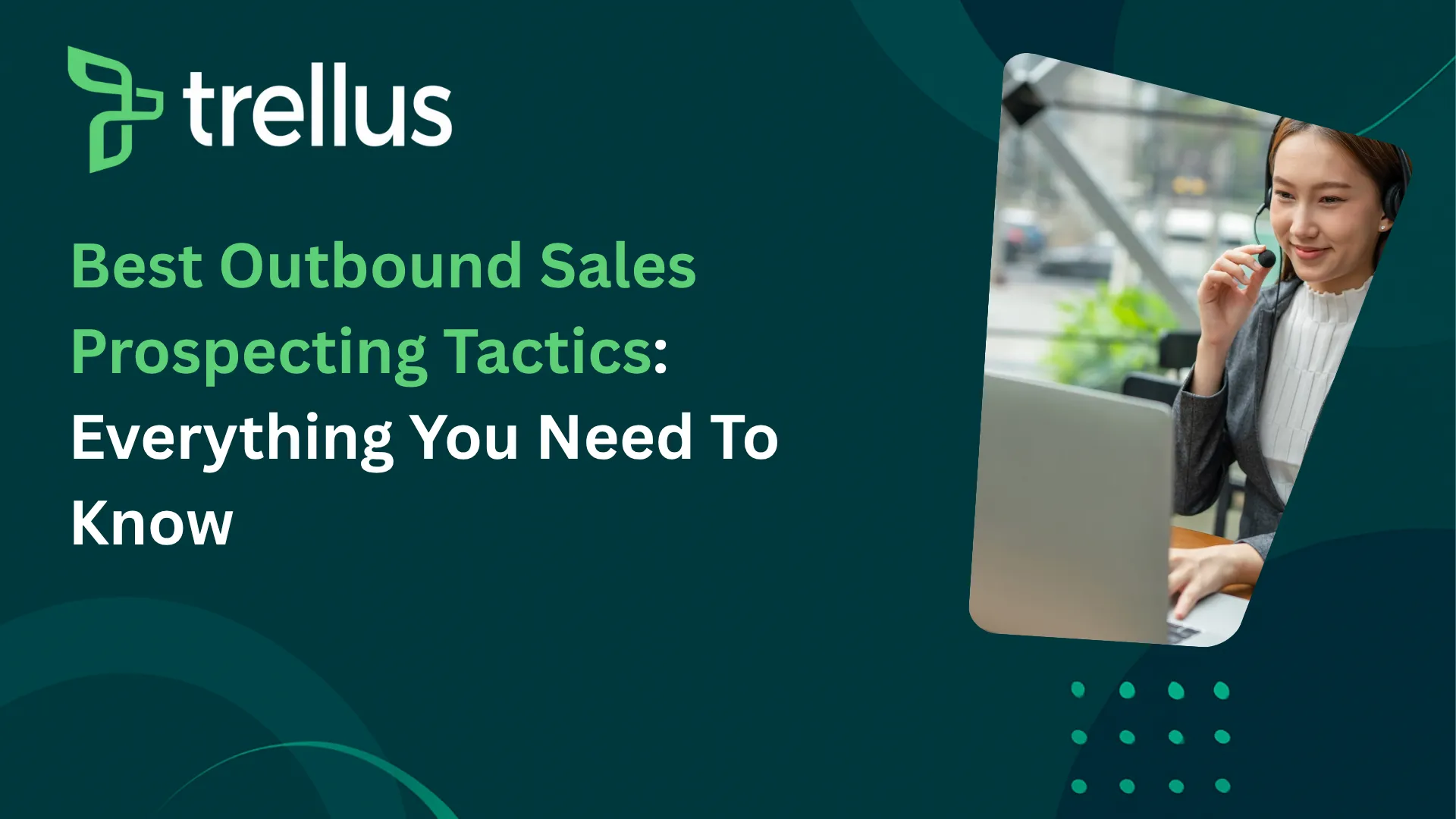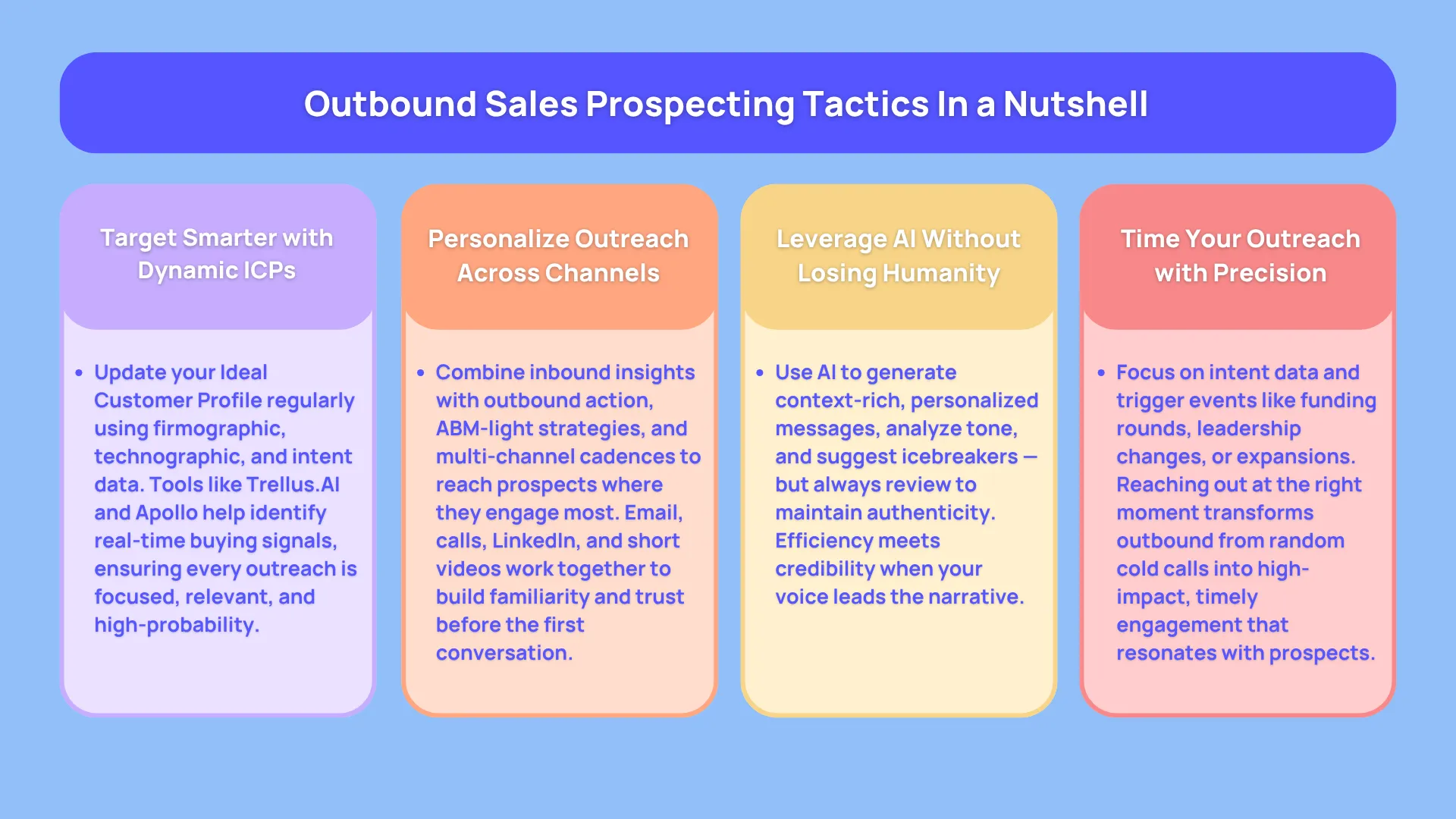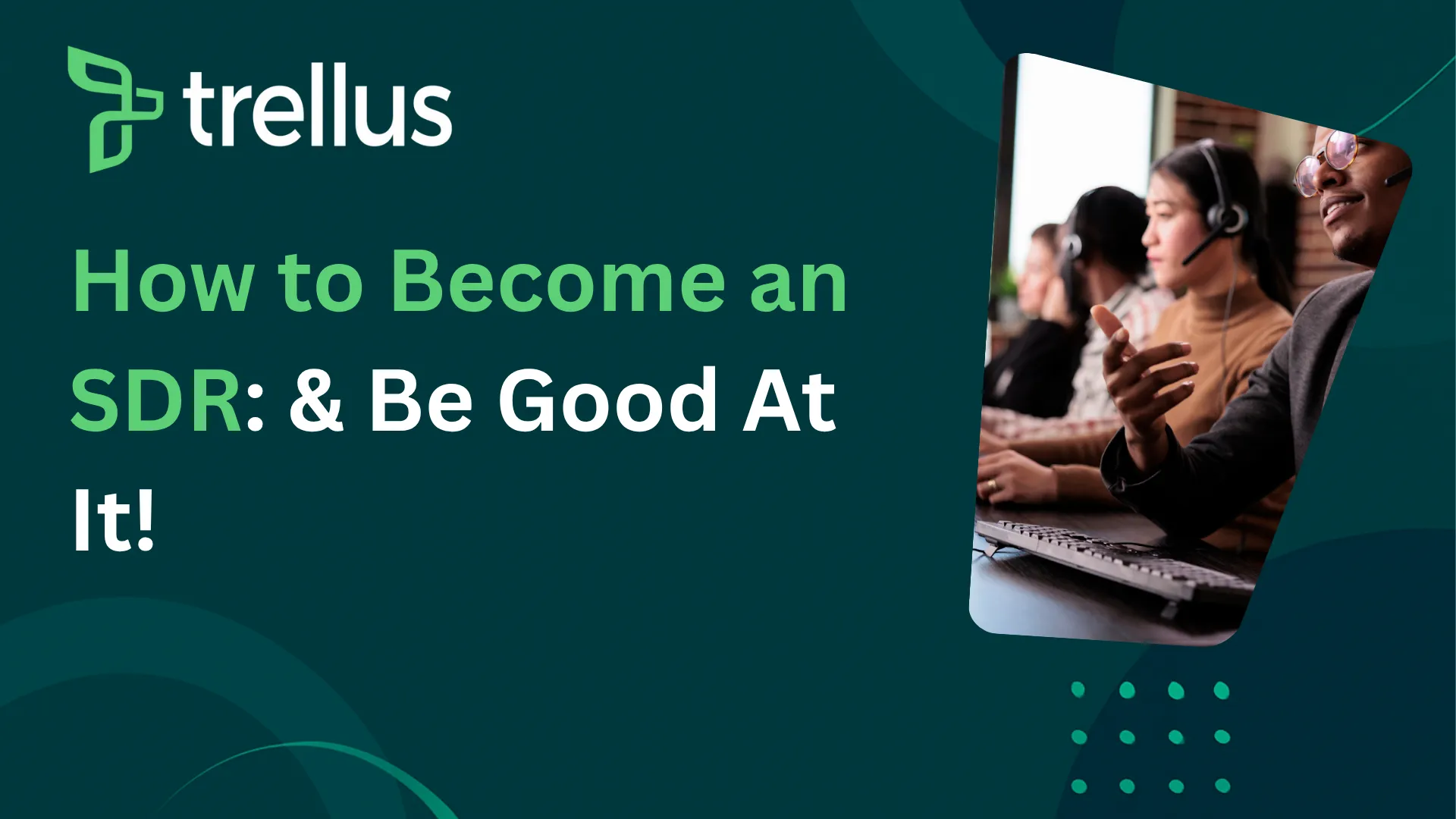
Our Top Picks


Outbound prospecting in 2025 is no longer about brute force.
The days of endless cold calls and spray-and-pray email campaigns are long gone by now.
Today’s most effective outbound strategies blend precision, personalization, and psychology, powered by data but executed with a distinctly human touch.
With buyers becoming more self-educated and tech stacks overflowing with automation tools, it’s the reps who master how and when to engage that win consistently. This guide breaks down 20 of the most powerful outbound prospecting tactics for 2025, drawn from real-world sales teams, top-performing SDRs, and modern AI-enabled workflows.

1. Precision Targeting with ICP Refinement
Everything starts with clarity. A weak or outdated Ideal Customer Profile (ICP) leads to wasted activity, unqualified leads, and frustrated reps. In 2025, your ICP isn’t static; it’s a living data set.
The best teams use firmographic, technographic, and intent data together. Tools like Trellus.Ai, Apollo, Nooks, and Orum allow you to identify buying signals in real time: new funding, leadership hires, or tech stack changes.
Update your ICP quarterly and layer in data that reflects current pain points, not last year’s assumptions. The sharper your ICP, the more every message feels like it was written for them.
2. Warm Outbound: Combining Inbound Insights with Outbound Action
Outbound and inbound shouldn’t operate in silos. Top SDRs now use inbound behavior to fuel outbound precision.
When a prospect downloads a whitepaper or visits your pricing page twice, they’re already signaling interest , even if they haven’t reached out. Pair that engagement data with a personalized outbound message referencing their activity.
Example:
“Hi Sarah, noticed you were exploring our AI forecasting tools , curious what challenges you’re seeing with pipeline accuracy this quarter?”
It’s no longer “cold” outreach when timing and context are on your side.
3. Account-Based Personalization (ABM Light)
Full-scale ABM programs are resource-intensive, but “ABM Light” , personalization at scale , delivers nearly the same impact with half the complexity.
Use templates that personalize around account-level insights: company goals, industry shifts, or competitor activity. For example:
“I saw [Competitor] just launched an AI feature for workflow automation , curious how your team is approaching that challenge?”
It’s focused, relevant, and strategic , the kind of message that cuts through generic outreach.
4. Leveraging AI for Hyper-Personalization
AI has made personalization faster, not lazier. The best reps use AI to generate context, not clichés.
Feed your AI assistant with recent news, LinkedIn posts, and company data to create icebreakers that sound human. Tools like Humantic, Lavender, or Regie.ai can analyze tone, personality, and buyer intent to adjust your outreach style.
The key? Always review before sending. AI gives you efficiency, but your voice gives you credibility.
5. Crafting the “Pattern Interrupt” Cold Call
Everyone expects a sales pitch. That’s why a pattern interrupt , something unexpected , resets attention and sparks curiosity.
Example opener:
“Hey Tom, this isn’t a cold call , it’s a quick context check. I noticed you’re scaling your ops team, and I’ve got a 10-second question about that.”
It’s confident, disarming, and human. You’re not begging for time; you’re leading with relevance. In 2025, the reps who master the first 10 seconds of a call control the next 10 minutes.
6. Multi-Channel Cadences That Mirror Human Behavior
Buyers move between channels , email, LinkedIn, phone, and even voice notes. Your outreach cadence should do the same.
Instead of hammering one medium, build multi-channel sequences that reflect how real people communicate. A well-crafted 10-step cadence might include:
- 8 to 10 calls, or more on an as needed basis
- 3 personalized emails
- 3 LinkedIn touchpoints
- 1 voicemail
- 1 creative follow-up (like a short video message)
Consistency across channels builds familiarity. And familiarity builds trust , even before a conversation happens.
7. Social Selling with Authenticity
Social selling isn’t posting memes and hoping for leads. It’s about creating micro-moments of credibility.
In 2025, buyers research you as much as your company. That means your LinkedIn presence matters , your posts, your comments, and your tone. Share insights that teach, not pitch. Comment intelligently on industry conversations. Connect with value first.
The goal isn’t vanity metrics , it’s visibility with purpose.
8. Personalized Video Prospecting
Video still outperforms plain text in response rates, especially when used strategically. A 30-second, personalized video that references the prospect’s company or problem is often enough to stand out in a crowded inbox.
Example script:
“Hey Rachel, noticed your team recently expanded into Europe , congrats! I’ve worked with a few teams navigating similar transitions and wanted to share a quick insight…”
Keep it short, genuine, and relevant. Personal video messages humanize your outreach and show effort where automation fails.
9. Using Intent Data for “Right-Time” Outreach
Timing beats volume. Platforms like 6sense, Bombora, and Demandbase can surface intent signals that reveal when an account is actively researching your solution category.
Instead of sending 500 cold emails, send 50 timely ones , when the buying window is open. This turns outbound into something much closer to inbound: proactive yet perfectly timed.
10. Trigger-Based Prospecting
Great outbounders think like detectives. They don’t just target accounts , they monitor changes within them.
Hiring sprees, funding rounds, new leadership hires, or expansion announcements are perfect trigger events. Each indicates momentum, and momentum often means budget.
Use tools like Crunchbase, LinkedIn Sales Navigator, and Google Alerts to set up automated triggers. Then act fast , the first rep to reach out after a business change often wins the meeting.
11. The Challenger Sales Approach
The “Challenger” mindset separates top performers from average reps. Instead of agreeing with every statement or pushing a pre-scripted pitch, Challenger reps teach, reframe, and lead.
In 2025, prospects don’t need information , they need interpretation. A Challenger rep brings unique market insight that helps buyers see their problem differently.
Example:
“That’s interesting , most SaaS leaders I talk to thought they had a pipeline issue too, but when we dug deeper, it turned out to be rep-level lead hygiene. Have you noticed something similar?”
This approach positions you as a consultant, not a vendor. You’re not selling , you’re guiding. When paired with empathy and expertise, the Challenger style builds credibility fast, especially in high-ticket B2B sales.
12. Multi-Threaded Outreach
Single-threading (talking to one contact per account) is a dangerous gamble. People change roles, budgets shift, and one internal skeptic can stall a deal indefinitely.
Multi-threaded outreach means engaging multiple stakeholders , decision-makers, influencers, and end users , in parallel.
For example:
- Reach out to a VP of Sales with ROI data.
- Contact their RevOps manager about implementation ease.
- Loop in an SDR leader with talk tracks or training angles.
By building internal alignment early, you reduce friction later. Deals close faster because you’ve built multi-dimensional trust inside the organization.
13. Storytelling Through Case Studies
Facts tell. Stories sell.
Outbound messages packed with product specs often get ignored , but a brief, narrative-driven case study captures attention.
Example:
“We helped a logistics company like yours cut manual scheduling by 42% , the VP said it was like ‘hiring two extra reps without adding headcount.’ Want me to share what they changed?”
In 2025, storytelling isn’t a soft skill , it’s a differentiator. It translates outcomes into emotion and makes the ROI feel real.
Use mini-case stories in your cold calls, emails, and social content to move conversations from curiosity to conviction.
14. Leveraging Referrals and Warm Introductions
Referrals convert 3–5x higher than cold leads. Yet most reps still treat them as “nice-to-haves.”
Systematize your referral process: after every successful onboarding, renewal, or NPS survey, ask for introductions. Use LinkedIn’s “mutual connections” view to identify warm paths into target accounts.
Example message:
“Hi Alex, I noticed you’re connected to Priya over at [Company]. We recently helped your team streamline their demo booking flow , would you be open to an intro?”
Warm introductions reduce skepticism instantly , and often skip the gatekeepers altogether.
15. Voice Notes and Looms for Pattern Breaks

Inbox fatigue is real. By 2025, even “personalized” emails feel robotic. That’s why voice notes and short Loom videos are breaking through.
Hearing your tone or seeing your face builds instant human connection. A 20-second voice note saying, “Hey, saw your recent post about scaling SDR productivity , got a quick idea that helped a few teams like yours,” sounds natural and respectful.
It’s informal, direct, and stands out in a sea of templated text.
16. Using Community Intelligence
Communities like RevGenius, Pavilion, and Modern Sales Pros have become goldmines for outbound insight. Smart reps don’t just sell there , they listen.
Watch what problems keep surfacing in community threads. Track which tools or tactics are gaining traction. Use that intel to shape your outreach narrative:
“Noticed a few GTM leaders in Pavilion discussing how SDR productivity is stalling due to tool fatigue , is that something you’re seeing too?”
You’re not guessing pain points , you’re echoing what the market is already saying.
17. “Give-to-Get” Offers
Instead of immediately asking for 30 minutes, offer something valuable upfront. This “give-to-get” approach flips the power dynamic.
For instance:
“We just ran a benchmark report on conversion rates across 300 SaaS teams , happy to share where you stack up if helpful.”
When you lead with value, you earn attention and credibility. In 2025, prospects expect reciprocity , the old “can I get 15 minutes?” opener no longer works.
18. Using Post-Sale Data for Prospecting
Your existing customers are a goldmine of outbound intelligence. Analyze why they bought, how they implemented, and what measurable results they achieved.
If you notice that your strongest customers all share a specific tech stack or growth stage, use that pattern to refine new outreach.
Post-sale data tells you not just who to target, but why they’ll care. The result? Sharper ICPs and faster deal cycles.
19. Collaborating with Marketing for Precision Campaigns
The line between sales and marketing has blurred. In 2025, outbound thrives when SDRs and marketers operate as one team.
Sync on campaign timing, messaging, and retargeting. When a lead engages with a marketing asset , like a webinar or ad , follow up within 24 hours.
The prospect experiences a seamless journey, and you leverage warm intent with perfect timing. Outbound is no longer “cold” when every message feels coordinated.
20. Continuous Optimization and A/B Testing
Even the best outbound sequence decays over time. Buyer behavior evolves, inbox algorithms shift, and new channels emerge.
Top SDRs treat outreach like an experiment:
- Test subject lines weekly.
- Swap call openers monthly.
- Measure reply rate, meeting rate, and conversion rate separately.
The best teams don’t guess what works , they prove it with data. The result is continuous improvement at scale.


.jpeg)



